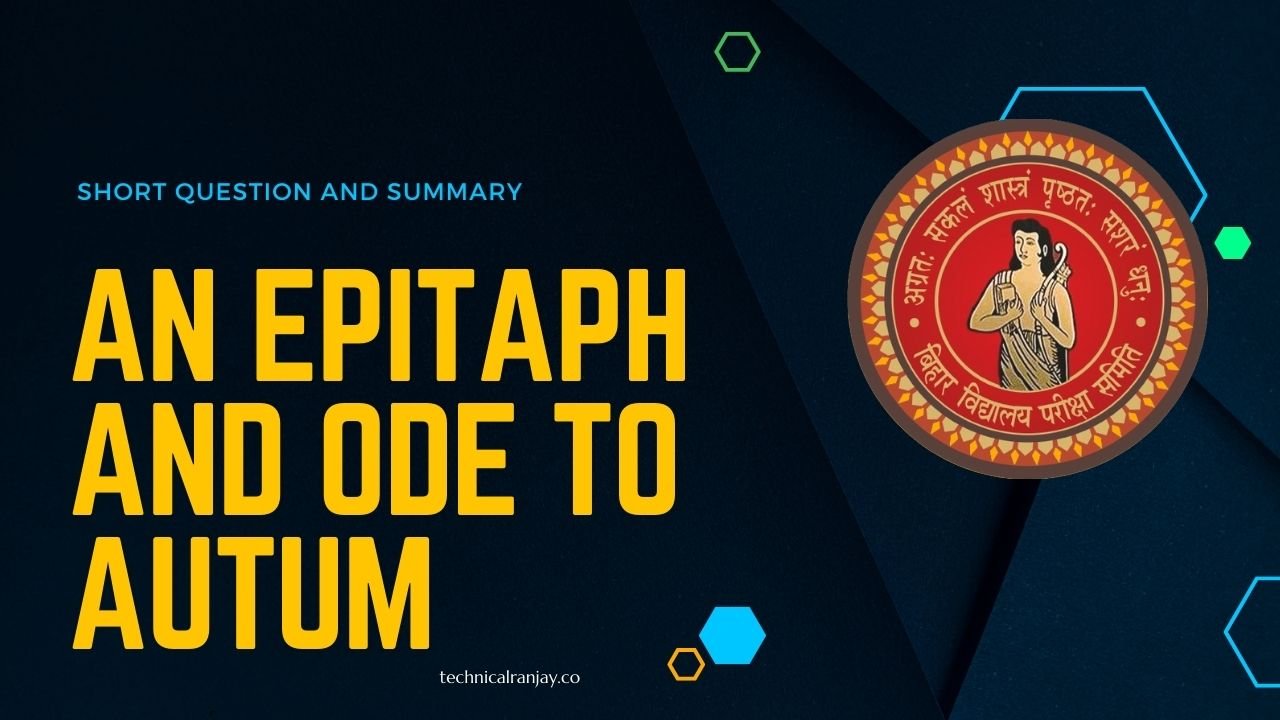An Epitaph’ is a beautiful short poem composed by book Walter de La Mare. It is heart touchable poem. In this love Tead poem, the poet tells us about the most beautiful lady of a western country who is no move in this world. The poet To death with the transitoriness of human life and human relationships.
The poet expressed his bad feeling for a beautiful lady the who has died. She was light of step and heart. Her beauty cial was very attractive, but it is short lived.
There is no way to save beauty from destruction. After her death, her beauty vanishes and passes. The poet loved her so much that when she was dead, he was weeping bitterly. He used to sit on her eptiaph, where she was laid down. The poet feels that no body will remember after his death. The poet wants to say that if a lover loves someone too much by heart can never leave her alone.
At last the poet says that beauty vanishes but the moral works always be remembered.
Ode to Autumn Summary
‘Ode to Autumn’ is a remarkable poem which has beening composed by the great romantic poet John Keats. The poet John keats is a great lover of nature. In this poem, S the poet describes the beauty and music of autumn in a series of memorable pictures.
John Keats says that autumn is one of the best season of the year. He says that autumn is the season of mists and ripening of fruits. Vines are full of all fruits with ripeness. New leaves and fruits grow on tree. There is neither heat of summer nor bitterly coldness of winter. The rays of the sun make the fruits fleshy eat and tasty. Nature looks beautiful everywhere. Wind blows friendly. Birds sing in a fine tune. People are happy in this season. They can do their work easily in this season.
John Keats presents autumn as a store house of music. He says that autumn is not without its music. Nature remains calm and cool in this pleasent season everywhere.
‘Ode to Autumn’ Short Question
1. How do the sun and summer help in ripeness of fruits in autumn?
Ans. The sun and summer help in the ripeness of fruits They and to make them fleshy or flat in autumn. The fillvery much heat and energy.
2.How are autumn and summer related to spring?
Ans. – John keats in his poem Ode to Autumn says that tert autumn and summer are related to spring. It comes before the arrived of summer. Autumn starts with the departure of the summer season.
3. How does Keats personify autumn in the poem?

Ans.-Keats in the poem ‘Ode to Autumn’ personifies Mit autumn by presenting it in four aspects of the seasonal als activities. Firstly, autumn is personified as a harvester, ricarelessly playing with her hair while seated in the granary floor. Secondly, it is personified as a tired reaper who falls. asleep as if drugged by the fragrance of the poppy flowers. Thirdly, it is personified as a gleaner on her way home with loads on her head. And finally, it is personified as a cider- presser who watches the apple juice oozing out.
4. What are the spring and autumn conspiring for?
Ans. The spring and the autumn are conspiring with each other to bring happiness, life and fruitfulness on this earth with the coming of the spring season. They behave like bosom friends who plan to make this earth a better place to live in and thus bring forth happiness into this world.
5. Why is the sun said to be maturing in the poem ‘Ode to Autumn’?
Ans. In the poem ‘Ode to Autumn’, the sun is at its fall and so is said to be maturing during this autumn season. The heat is pleasant and its light is not as bright as it is during the hot summer season.
6. In what sense does the sun conspire with autumn?
Ans. The sun conspires with the autumn by offering fruits and flowers. Its ray makes the fruit fleshy and fat and also tasty.
7. Who are depicted as friends in the first two lines?
Ans. It is the sun who is depicted as a friend of the autumn season in the first two lines of the poem because it helps bringing maturity or ripeness to fruits and flowers during the season.
1 thought on “An Epitaph And Ode to Autumn Summary Poems”